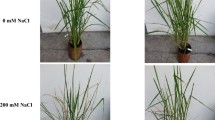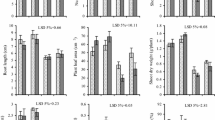Abstract
Salinity is a major yield-reducing stress in many arid and/or coastal irrigation systems for rice. Past studies on salt stress have mainly addressed the vegetative growth stage of rice, and little is known on salt effects on the reproductive organs. Sodium and potassium uptake of panicles was studied for eight rice cultivars in field trials under irrigation with saline and fresh water in the hot dry season and the wet season 1994 at WARDA in Ndiaye, Senegal. Sodium and potassium content was determined at four different stages of panicle development and related to salt treatment effects on yield, yield components and panicle transpiration. Yield and yield components were strongly affected by salinity, the effects being stronger in the HDS than in the WS. The cultivars differed in the amount of salt taken up by the panicle. Tolerant cultivars had lower panicle sodium content at all panicle development stages than susceptible ones. Panicle potassium concentration decreased with panicle development under both treatments in all cultivars, but to a lesser extent in salt treated susceptible cultivars. Grain weight reduction in the early panicle development stages and spikelet sterility increase in the later PDS were highly correlated (p < 0.01) with an increase in panicle sodium concentration in both seasons, whereas reduction in spikelet number was not. The magnitude of salt-induced yield loss could not be explained with increases in sodium uptake to the panicle alone. It is argued that the amount of sodium taken up by the panicle may be determined by two different factors. One factor (before flowering) being the overall control mechanism of sodium uptake through root properties and the subsequent distribution of sodium in the vegetative plant, whereas the other (from flowering onwards) is probably linked to panicle transpiration.
Similar content being viewed by others
References
Afridi M M, Ali Q and Dwivedi R S 1988 Effect of salinity on growth and ionic composition of Oryza sativa and Diplachne fusca. J. Ind. Bot. Soc. 67, 166-182.
Aslam M, Qureshi R H and Ahmad N 1993 A rapid screening technique for salt tolerance in rice (Oryza sativa L.). Plant Soil 150, 99-107.
Asch F, Dörffling K and Dingkuhn M 1995 Response of rice varieties to soil salinity and air humidity: A possible involvement of root-borne ABA. Plant Soil, 177, 11-19.
Asch F 1996 Air humidity effects on transpiration differ among rice varieties subjected to salt stress. In West Africa Rice Development Association, Annual Report 1995. BP 2551, Bouake 01, Cote d'Ivoire.
Asch F, Dingkuhn M and Dörffling K 1997a Physiological stresses of irrigated rice caused by soil salinity in the Sahel. In Irrigated Rice in the Sahel: Prospects for sustainable development. Eds. K M Miezan, M C S Wopereis, M Dingkuhn, J Deckers and T F Randolph. pp 247-273. West Africa Rice Development Association, BP 2551, Bouake 01, Cote d'Ivoire.
Asch F, Dingkuhn M, Wopereis M C S, Dörffling K and Miezan K 1997b A conceptual model for sodium uptake and distribution in irrigated rice. In Applications of Systems Approaches at the Field Level. Eds M J Kropff et al. pp 201-217, Kluwer Academic Publishers, Dordrecht.
Asch F, Dingkuhn M and Dörffling K 1997c Effects of transpiration on sodium and potassium distribution in salt-stressed irrigated rice. J. Exp. Bot. 48 supl. p 39.
Babu V R 1985 Seed germination, water uptake and seed reserve utilization of rice (Oryza sativa cv. Jaya) under growth regulator and salinity stressed conditions. Seed Research 13, 129-135.
Dingkuhn M, Asch F and Miezan K 1993 Salt tolerance of rice varieties under irrigated conditions in the Sahel. In West Africa Rice Development Association, Annual Report 1992. BP 2551, Bouake 01, Cote d'Ivoire.
Dingkuhn M, Miezan K and Asch F 1994 Developing better adapted and high-yielding rice varieties for the Sahel. In West Africa Rice Development Association, Annual Report 1993. BP 2551, Bouake 01, Cote d'Ivoire.
Dingkuhn M, Sow A, Samb A, Diack S and Asch F 1995 Climatic determinants of irrigated rice performance in the Sahel — I. Photothermal and micro-climatic responses of flowering, Agric. Syst. 48, 385-410.
Fageria N K 1985 Salt tolerance of rice cultivars. Plant Soil 88, 237-243.
Flowers T J and Yeo A R 1989 Effects of salinity on plant growth and crop yield. In Environmental Stress in Plants. Ed. J H Cherry. pp 101-119. Springer Verlag Berlin.
Flowers T J, Hajibagheri M A and Clipson N J W 1986 Halophytes. Quarterly Review of Biology 61, 313-337.
Garrity D P, Vidal E T and O'Toole J C 1986 Manipulating panicle transpiration resistance to increase rice spikelet fertility during flowering stage water stress. Crop Sci. 26, 789-795.
Gomez K A and Gomez A A 1984 Statistical procedure for agricultural research. John Wiley and Sons, Singapore. 460 pp.
Khatun S and Flowers T J 1995 Effects of salinity on seed set in rice. Plant Cell Environ. 18, 61-67.
Khatun S, Rizzo C A and Flowers T J 1995 Genotypic variation in the effect of salinity on fertility in rice. Plant Soil 173, 239-250
Mengel K 1980 Effect of potassium on the assimilate conduction to storage tissue. Ber. Deutsch. Bot. Ges. 93, 353-362.
Nair V G M and Rana R S 1987 Meiotic response to edaphic stresses in traditional rice cultivars of salt-affected areas. Trop. Ecol. 28, 88-91.
Neue H U, El-Naggar M I A and Rashid M 1990 Responses and tolerance mechanisms of rice to saline soil conditions. Transactions, Vol IV, 14th International Congress of Soil Science, Kyoto, Japan, 50-55.
Nitsos R E and Evans H J 1969 Effects of univalent cations on the activity of particulate starch synthetase. Plant Physiol. 44, 1260-1266.
O'Toole J C, Hsiao T C and Namuco O S 1984 Panicle water relations during water stress. Plant Sci. Lett. 33, 137-143.
Raes D, Deckers J and Diallo M 1995 Water requirements for salt control in rice schemes in the Senegal river delta and valley. Irrigation and Drainage Systems, 9, 129-141.
Raman S, Desai N D, Solanki J B and Bhatt S M 1986 The Na-K ratio as index of salt stress in rice cultures. International Rice Research Newsletter 11, 30.
Yamanouchi M, Maeda Y and Nagai T 1987 Relationships between varietal differences in salt tolerance and characteristics of sodium absorption and translocation in rice. Jap. J. Soil Sci. Plant Nutr. 58, 591-594.
Yeo A R and Flowers T J 1982 Accumulation and localisation of sodium ions within the shoots of rice (Oryza sativa) varieties differing in salinity resistance. Physiol. Plant. 56, 343-348.
Yeo A R, Caporn J M and Flowers T J 1985 The effect of salinity on photosynthesis in rice (Oryza sativa L.): Gas exchange of individual leaves in relation to their salt content. J. Exp. Bot. 36, 1240-1248.
Yoshida S 1981 Fundamentals of rice crop science. International Rice Research Institute, Los Banos, Philippines.
Yoshida S, Forno D A, Cock J H and Gomez K A 1976 Laboratory manual for physiological studies of rice. International Rice Research Institute (IRRI), Manila, Philippines.
Author information
Authors and Affiliations
Rights and permissions
About this article
Cite this article
Asch, F., Dingkuhn, M., Wittstock, C. et al. Sodium and potassium uptake of rice panicles as affected by salinity and season in relation to yield and yield components. Plant Soil 207, 133–145 (1999). https://doi.org/10.1023/A:1026407913216
Issue Date:
DOI: https://doi.org/10.1023/A:1026407913216




